Before starting this review, I want to extend my thanks to Happy Hen Toys for generously offering this review sample for the Blog. Happy Hen Toys has, in my experience, become on of the most reliable sources for extinct & extant animal brands alike in the United States. Be sure to check out their website at happyhentoys.com; more links will be provided below.


Schleich has a funny history with dinosaurs. First founded as a company in 1935, Schleich has been producing and selling dinosaur toys since the late 1970s, including European distribution for the famous Carnegie Collection from Safari ltd. Marketed as a brand which encourages imagination and storytelling, Schleich has produced a wide variety toys and replicas for child’s play, ranging from licensed IP characters to natural wildlife and prehistory. Schleich has also been known to advertise their figures as “authentic” in detail and quality: “crafted to look like the real thing”, as their own website puts it. Imagination and education are the Germany-based company’s mantra.
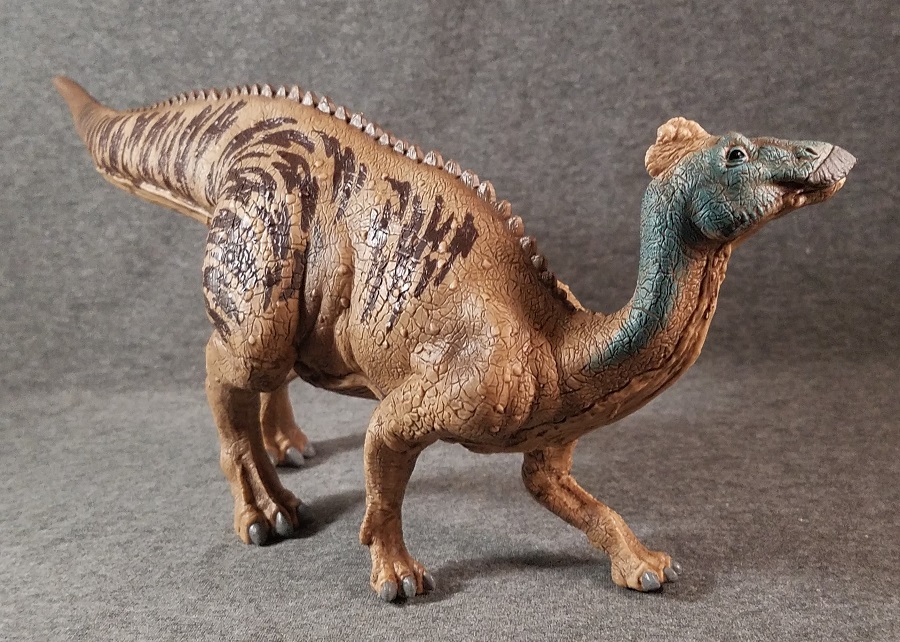
Those proclaimed qualities of education and “authenticity”, however, have been long-running drawbacks for their dinosaurs. Schleich’s figures are quite durable and technically well-detailed, so they certainly make for good toys; but when it comes to design, Schleich’s approach to dinosaurs tends to favor imitating monsterized pop culture depictions, rather than scientifically-backed life replicas. There have been exceptions to this trend, thankfully; but for collectors it has become a real gamble anticipating whether or not Schleich will take one step forward or two steps back with each new year. Now that Schleich’s 2023 releases are hitting retailers and becoming available for purchase, the question rears its head again: do any of the new dinosaurs raise the bar?
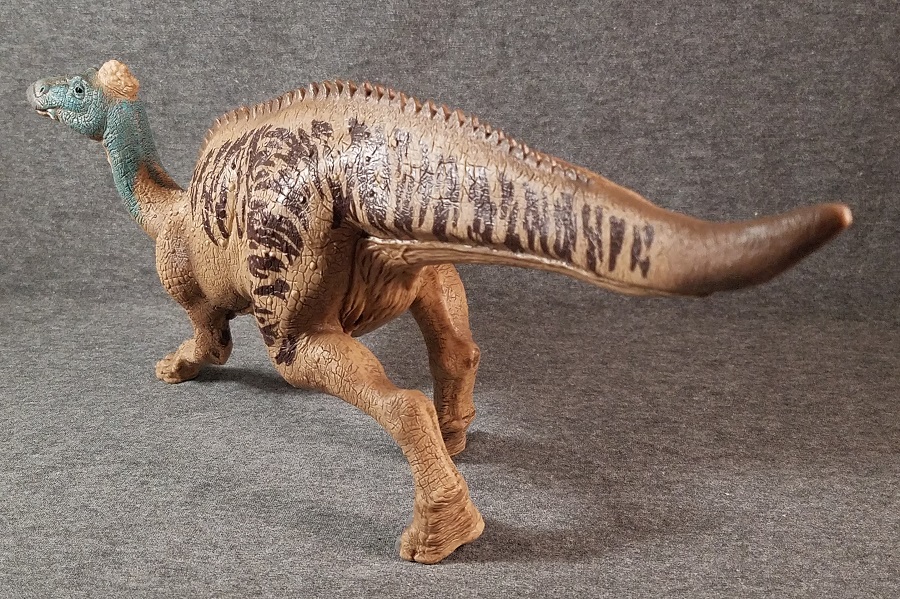
Among Schleich’s new dinosaur figures is Edmontosaurus, a genus the German company hasn’t touched since 1997. Edmontosaurus is, simply stated, a true icon of the Mesozoic era. Whether you know it better by Anatosaurus, Anatotitan, or even Claosaurus, the “Edmonton lizard” has been a staple genus of dinosaur art and science for at least a century. Known from numerous specimens, Edmontosaurus has two currently recognized species under its name (E. regalis and E. annectens), and would likely have been a common sight in Late Cretaceous North America, traveling in herds across the landscape to browse all manner of edible vegetation. What Edmontosaurus lacked in teeth or horns, it made up for in size: both species could have averaged 9 meters in length, with the largest individuals reaching 12 or even 15 meters. Edmontosaurus would have been one of the largest animals in its environment, rivaling or outmatching the biggest ceratopsians and tyrannosaurs (yes, that includes T. rex itself!). The Late Cretaceous was a spectacular age of giants from all walks of dinosauria.

Schleich’s new Edmontosaurus is a fairly sizable rendition itself, measuring 30cm (11.75in) from nose to tail, or 34.5cm (13.5in) along the spine. This size places the figure within the range of 1:26 to 1:38 scale, for a specimen between 9 to 13 meters in life. Apart from the size, the most striking trait of the figure is the color scheme: the sandy brown base color is punctuated by swirling coffee-brown stripes across the body and hind legs, with aqua blue highlighting the neck and face. It’s an eye-catching color scheme and probably one of Schleich’s better schemes – albeit one that’s lifted straight from the character model of the online game Jurassic World Evolution. Some collectors will roll their eyes at seeing yet another toy aping the Jurassic franchise so shamelessly; however Schleich is hardly the first company to reference coloration from another artist or media source, Jurassic Park/World or otherwise. Personally, I think copying a video game color scheme (especially one as nice as this) is much a much more preferable manner of drawing inspiration to crudely aping what are decades-old, stylized movie monster designs, as Schleich has frequently done in the past.
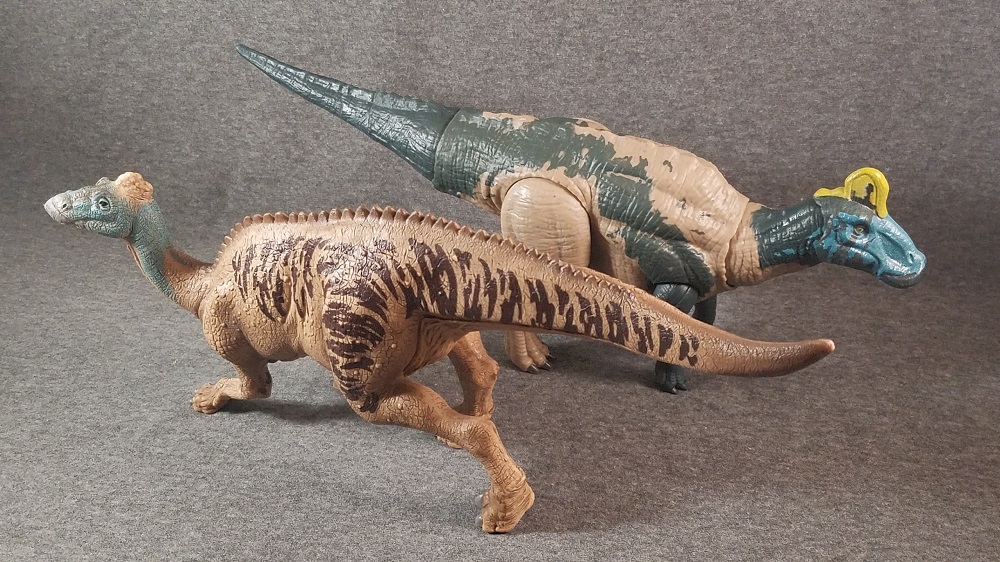
Ironically, Schleich’s Edmontosaurus might have benefited from more than just coloration imitation from the Evolution game. Based closely on artwork provided by paleoartist Julius Csotonyi for the original Jurassic World movie website, Evolution’s creature model is pretty up-to-date in terms of scientific understanding of the animal, for the most part. Schleich’s model, in contrast, is quite uneven when given careful inspection. Schleich does not specify what species their model represents, but the model does feature a fleshy crest/comb atop the back of the head, which is a trait specifically known from E. regalis at this point in time. The crest is rather wrinkly and bulbous in appearance, but its presence is a welcome one for a modern representation of the animal.
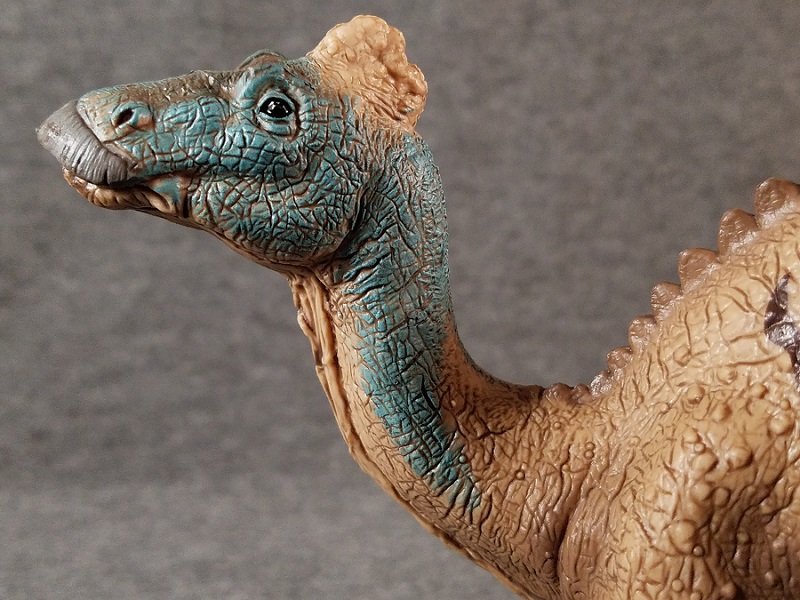
Past the comb, however, we start finding problems. When (roughly) measured up against skeletal proportions of E. regalis, the torso and tail are pretty close to correct – although the tail is a bit short and the belly has an odd shape, as though the animal were sucking its gut in. The head, meanwhile, resembles the shape of a juvenile specimen, but it looks very small and out of place attached to a body this size. The neck, in contrast, is slender and swan-like, which contradicts the short, robust nature of the hadrosaur’s known neck vertebrae. The limbs appear correct in sum length, even though the crouched posture of the figure belies this; however the individual dimensions of the upper and lower limb bones are inconsistent, further distorting their overall appearance.
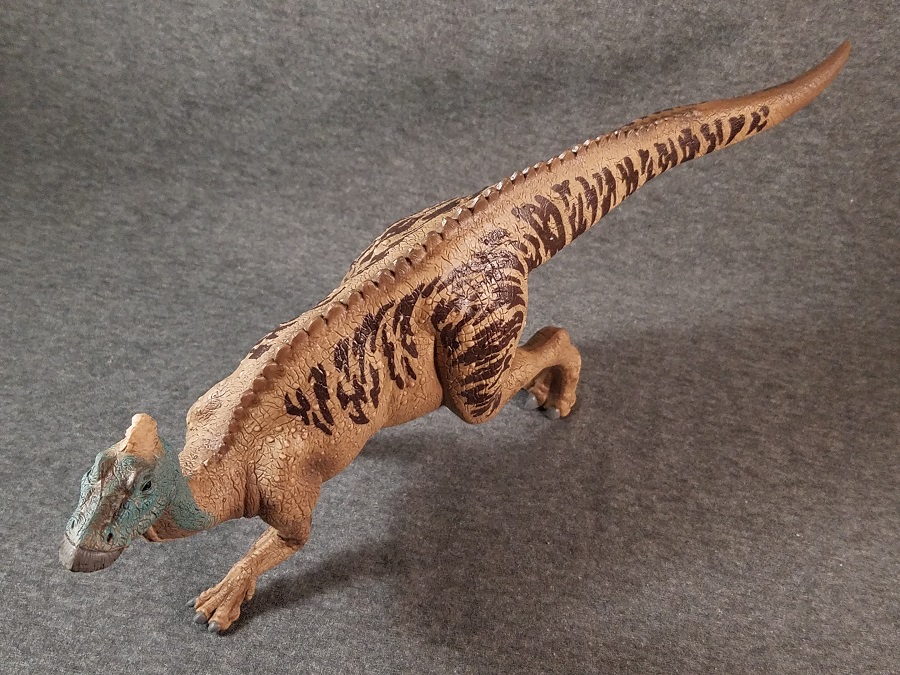
Edmontosaurus is a dinosaur which scientists are privileged to have discovered multiple skin samples of between a few different specimens, so we have more of an idea about Edmontosaurus’s life appearance than most dinosaurs. Integument of Edmontosaurus largely consisted of non-overlapping tubercle scales of differing sizes and clusters, with prominence on the neck and hip regions. Schleich is typically good at applying a high level of finer details to their dinosaur models; but for Edmontosaurus, a craggly, irregular texture akin to cracked mud makes up most of the skin texture, with a smattering of osteoderms along the flanks. It’s detailed, but honestly not up to Schleich’s prior standards of dino skin texturing; and it’s a particularly poor representation for qualities we have hard evidence of in the fossil record. Contrasting this texture is a length of wrinkled, baggy-looking skin running the full length of the figure’s underside, chin to tail tip. I’m honestly at a loss for what to compare this texture with, short of possibly the soft skin of a large salamander – which would be a perplexing choice at best and a horrendously outdated choice at worst for a dinosaur restoration.
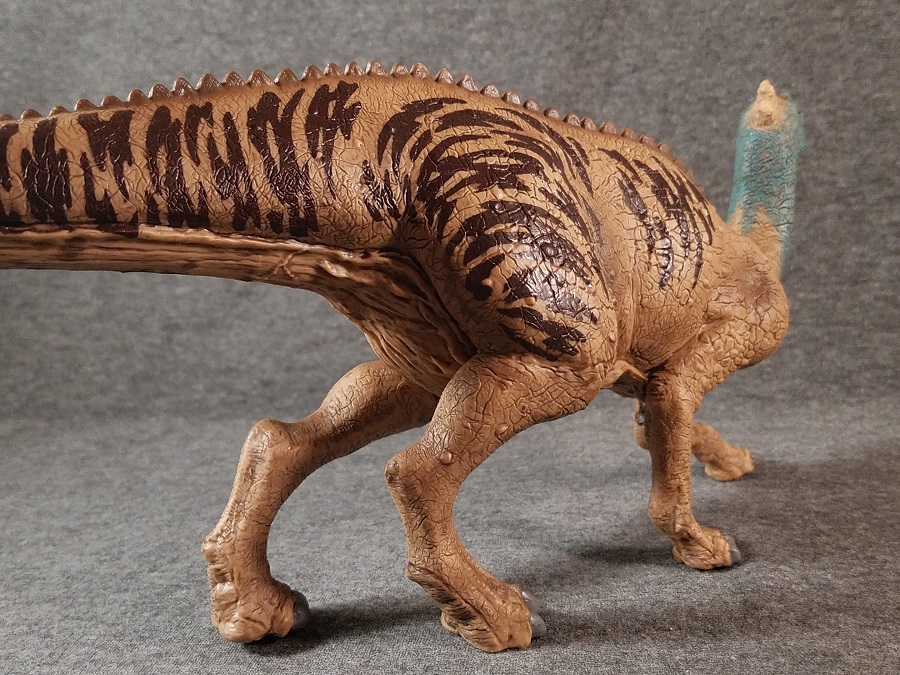
The most egregious gaff of all, though, has to do with the feet. In October of 2019, a surprising photo began circulating the social media paleosphere featuring what appeared to be a mummified dinosaur “hoof”. This foot belonged to a specimen of E. annectens nicknamed “Dakota”, which was first discovered in the 90s but not yet fully extracted from the rock matrix. Current studies now indicate that Edmontosaurus’s front feet were built with the main three toes being housed in a fleshy “mitten”, sheathed with a single large hoof-like nail. Such a discovery is, of course, quite a dramatic departure from traditional toed depictions of the dinosaur, with potential ramifications for related hadrosaurs as well. Sadly, although several other toy companies were prompt in applying the new findings to their duck-billed dinosaurs, Schleich seems to have missed the memo: their Edmontosaurus bears the typicalthree separate digits (with the appropriate reduced outer digit higher on the foot). Most casual buyers will probably never notice this issue (and Jurassic World Evolution features the same inaccuracy with their digital model), but it’s disappointing to see a brand which markets itself as an educationally-based company make such a significant oversight – one which a simple Wikipedia article review could have remedied.
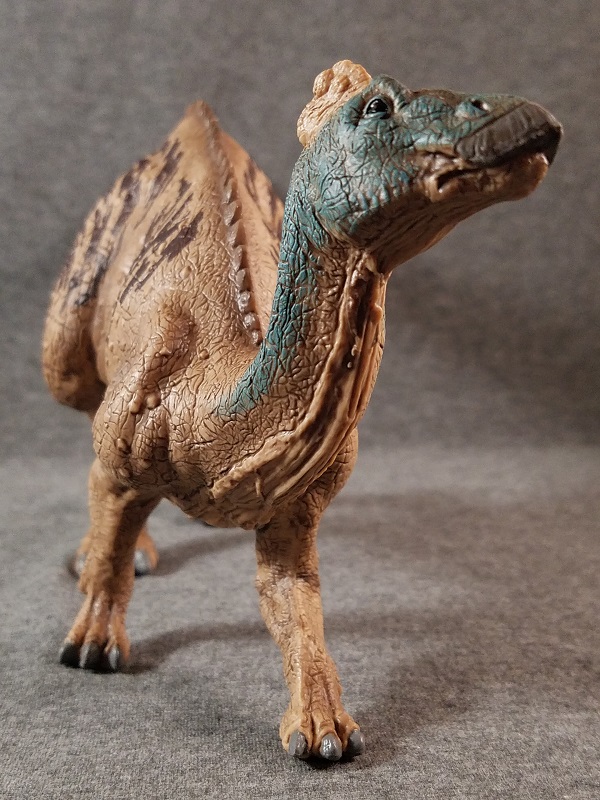
As a lifelike, educational replica, Schleich’s 2023 Edmontosaurus sadly falls short in several aspects – a reality that is unsurprising, but still disappointing. To Schleich’s credit, this is still a fairly dynamic and colorful figure; and it’s good to see more representation to “boring” dinosaur genera, especially a genus as historically significant as Edmontosaurus. Hopefully Schleich will be encouraged to tackle more ornithopod dinosaurs in the future – ideally with more rigorous research to reflect scientific accuracy.

My thanks again to Happy Hen Toys for providing this sample to review for the Blog. You can purchase this dinosaur figure, as well as Schleich’s full 2023 assortment, at their website happyhentoys.com.
Disclaimer: links to Ebay and Amazon on the DinoToyBlog are affiliate links, so we make a small commission if you use them. Thanks for supporting us!




Jó értékelés,és hát az Edmonto “beszívta a beleit”.
They completely Fucked up
Excellent review! It would have been easy to completely roast this toy but you took a more professional approach. Incidentally, I have the Schleich Edmontosaurus from the 90’s and it is a much lovelier figure than this.
I have the old classic too and also prefer it.